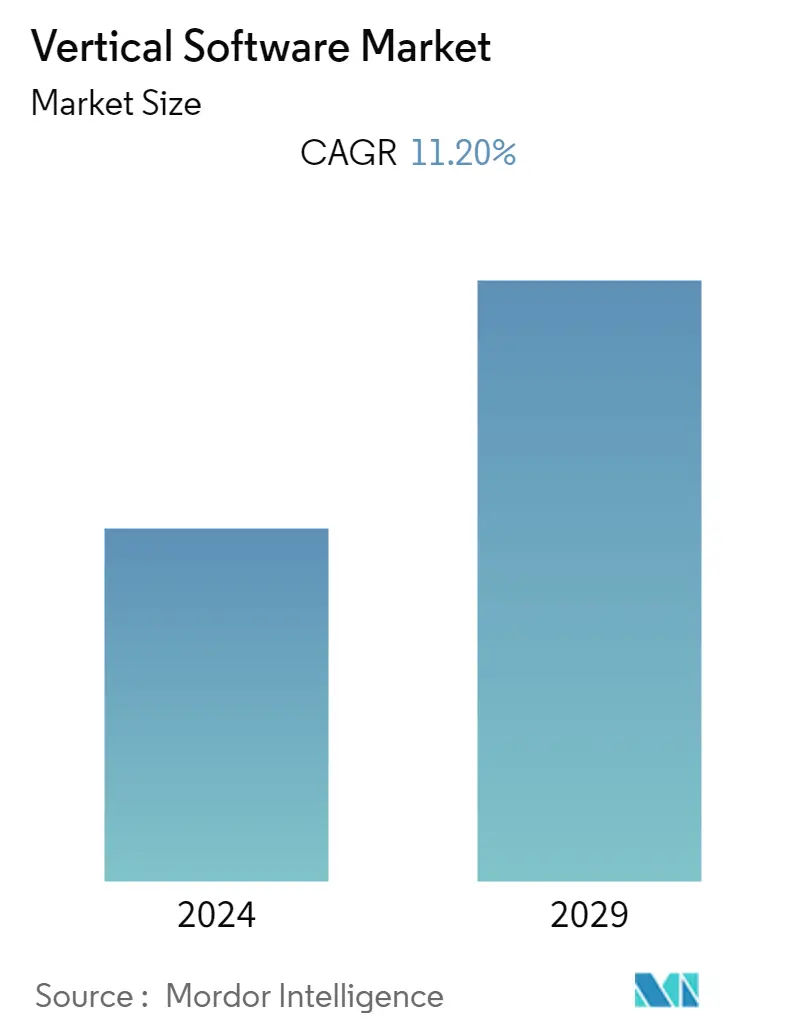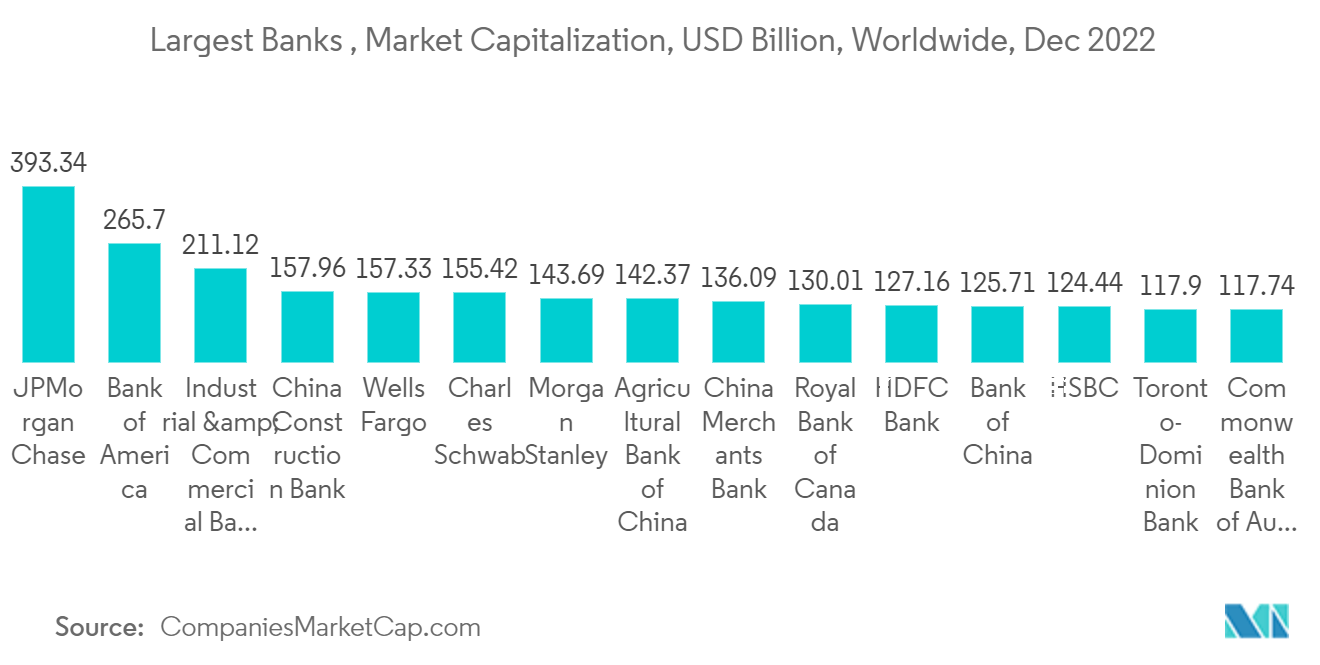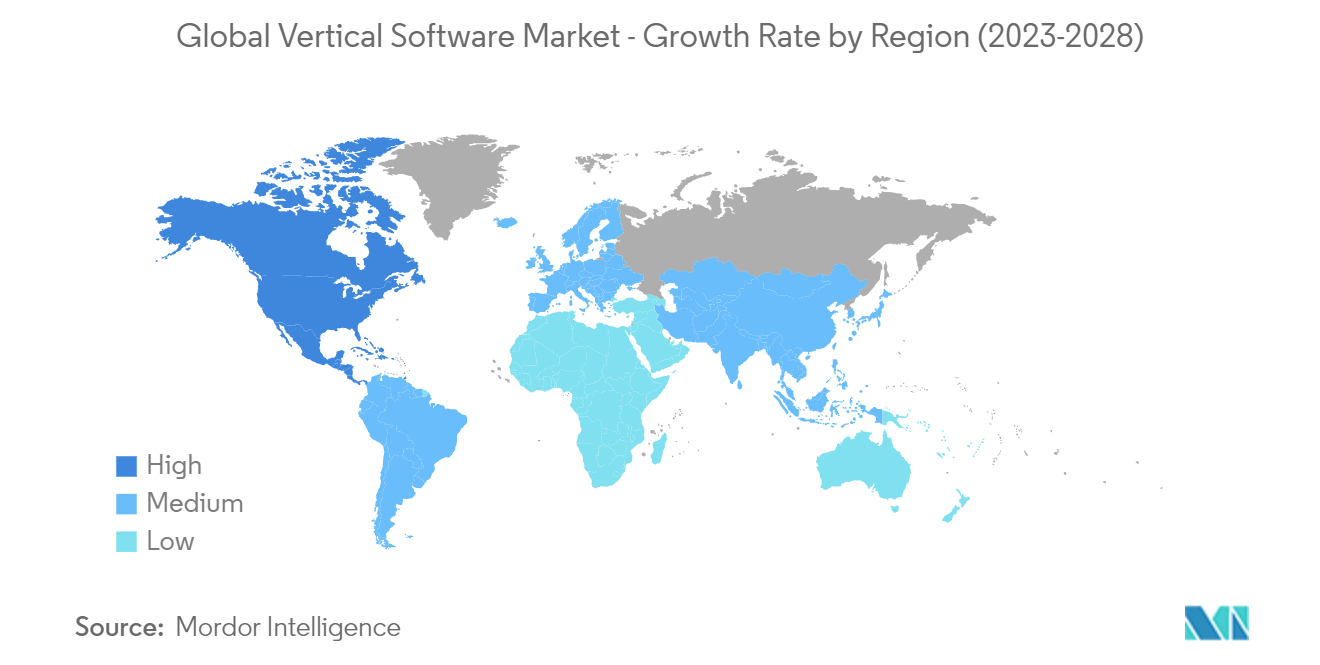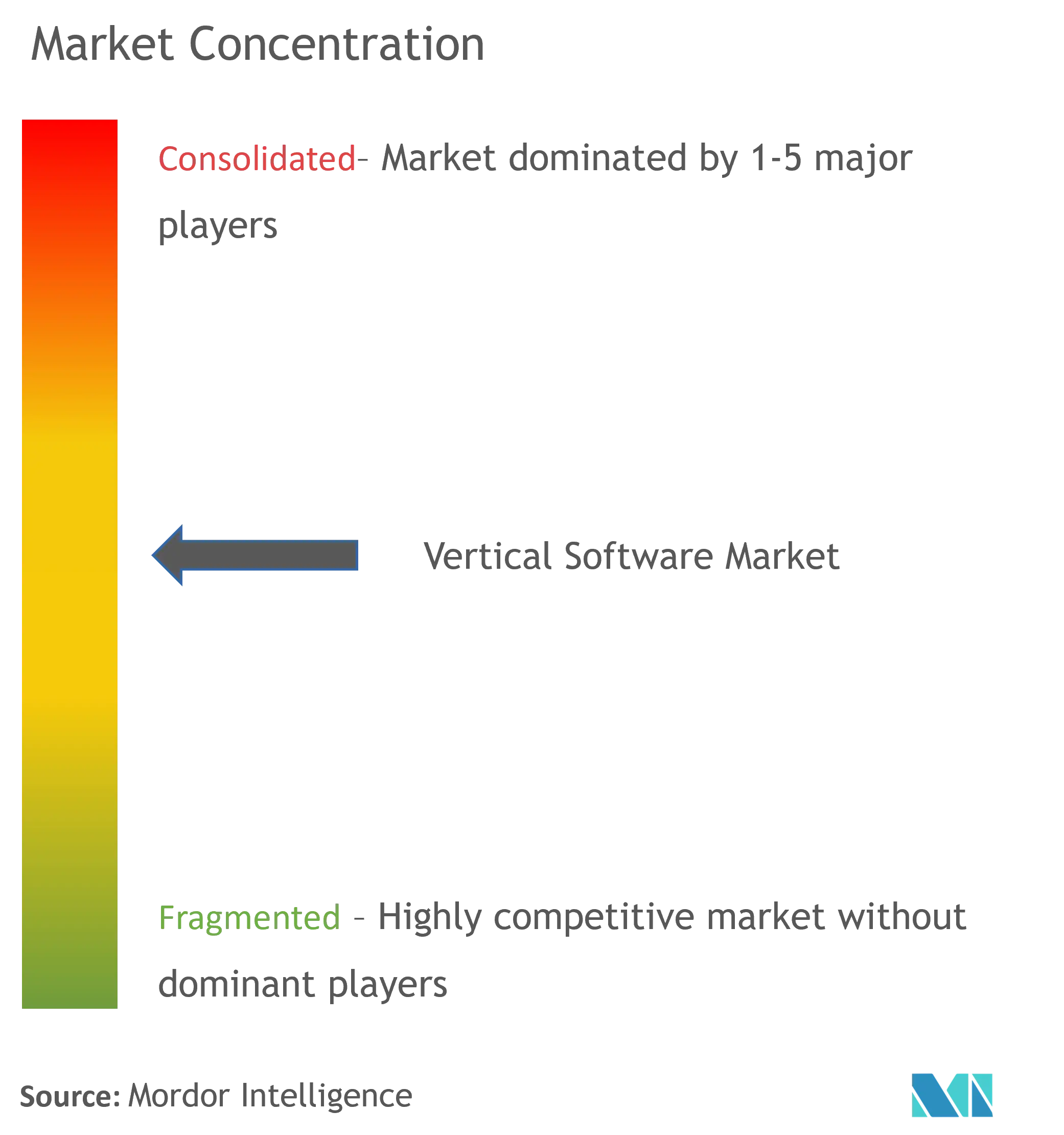
| Study Period | 2019 - 2029 |
| Base Year For Estimation | 2023 |
| Forecast Data Period | 2024 - 2029 |
| CAGR | 11.20 % |
| Fastest Growing Market | Asia-Pacific |
| Largest Market | North America |
| Market Concentration | Medium |
Major Players
*Disclaimer: Major Players sorted in no particular order |
Vertical Software Market Analysis
The vertical software market is expected to register a CAGR of 11.2 % over the forecasted period. Vertical market software includes a number of distinct advantages. Vertical market software assists in more effectively addressing industry-specific features and processes. In comparison to software for the horizontal market, it also assists organizations in obtaining superior integration with various functionalities and procedures. As a result of these features, the vertical software market size is expected to witness numerous growth opportunities during the forecasted period.
- Vertical software market leaders have the luxury of adding "integrated services" such as payment processing to their layer cake. Most financial services, such as payment processing, payroll, and lending, are commodities. You have the right to win against generic third-party suppliers as the trusted software vendor in your vertical by supplying a vertical-specific offering that is often more useable, inexpensive, and better integrated with this software. This method's significance is that businesses do not require customers to dip into their pockets and purchase more software. Firms instead replace something that customers already pay for, making the cross-sell feel "free" and lowering sales friction.
- For example, Shopify sources and underwrite business financing. Vertical software businesses with cash flow visibility are especially well-positioned to originate and underwrite loans. For example, Procore provides loans to assist construction companies in financing the acquisition of building materials when new work is awarded to them. Truckstop makes loans to trucking businesses after completing work that is secured by the amount they owe. Mindbody provides a cash advance against future payments made via the Mindbody platform.
- Some B2B2C vertical software companies are attempting to monetize the consumer rather than the merchant. FareHarbor is a software provider to the activity and tour operator markets. While most of its competitors paid operators a membership fee, FareHarbor provided free software and gained revenue by charging end-users a transaction fee. FareHarbor gained an advantage over more expensive competitors thanks to this revolutionary pricing approach.
- During the pandemic, various vertical industries collaborated with software firms to provide a better experience for customers. For instance, rootstock software, a prominent provider of ERP solutions, recently collaborated with Vertical Aerospace to debunk this misconception, completing the implementation of Rootstock's Cloud ERP in just three and a half months and amid the global COVID-19 outbreak.
- There have been more rules, and regulatory compliance management has grown in many different enterprises. Regulatory compliance processes and strategies guide organizations as they work to achieve their commercial objectives. Companies employ compliance software to ensure that all product components and production procedures meet all relevant legal requirements and benchmarks for industrial quality. Regulatory constraints are becoming more intense along many industry supply chains. Climate change-related environmental concerns, globalization and the resulting need to track, satisfy, and verify regulatory compliance from multiple locations, and mass customization, which necessitates regulatory compliance for an ever-increasing various of products in an ever-smaller variety of lots or batches, all contribute to these pressures.
Vertical Software Market Trends
BFSI is Expected to Drive the Market
- Fintech influences vertical SaaS go-to-market channels by increasing revenue per customer and making the product stickier. In other words, fintech maintains, if not decreases, the cost of customer acquisition (CAC) while improving lifetime value (LTV). Mindbody, for example, earned USD 250 per month per subscriber; while it charged USD 150 per month, or USD 1800 per year on average, for its software package, it made an additional USD 100 per month from payments income.
- Furthermore, because fintech can drastically enhance LTV, vertical SaaS companies might offer their SaaS product for cheaper (or even for free) to entice a client base that would otherwise be hesitant to digitize before piling on fintech goods as the primary revenue lever. Silo, an operating system for wholesale food wholesalers, does not now charge its customers for its software, which has allowed it to effectively land customers in an industry that has previously been resistive to software adoption.
- According to CompaniesMarketCap, As of December 31, 2022, JPMorgan Chase was the largest bank in the world by market capitalization. JPMorgan Chase's market capitalization was around USD 393 billion at the time, much higher than Bank of America's market capitalization, which was around USD 265.7 billion. JPMorgan Chase is also the largest bank in the United States in total assets but only the sixth largest globally. The such huge market capitalization of banks would create an opportunity for vertical software companies to deploy their solutions in those banks.
- With the rise in demand for vertical software in the financial sector, firms are providing various products to capture the market share. For instance, in July 2022, SAP Fioneer, a financial services software solutions provider and platform, launched a new vertical product strategy that drastically altered its client offering. Using a vertical strategy, three platforms will deliver IT solutions adapted to the individual market and client needs, allowing them to negotiate an increasingly complex financial world.
- Similarly, in February 2022, the new Databricks Lakehouse financial services edition aims at customers in the banking, insurance, and capital markets. It enhances the platform with industry-specific technical content such as solution accelerators, software code for financial service use cases such as fraud detection and sustainability, and interfaces to data sets and third-party data providers typically utilized by the sector. According to Databricks, the Lakehouse for Financial Services provides real-time analytics, business intelligence, and AI tasks on all data types in multi-cloud environments.

North America is Expected to Hold Major Share
- According to a Flexera Software poll of 514 IT executives in North America, 49% anticipate that IT spending in the region will increase as more firms focus on investing in collaboration platforms and services, communication, and other areas. This opens up new possibilities for suppliers in the collaborative whiteboard software market. Micro, a San Francisco-based firm, boasts 20 million users for its collaborative whiteboard, which includes Fortune 500 companies like Dell, Cisco, Deloitte, Okta, and Pivotal.
- The adoption of marketing automation software has been increasing in the region as there has been a shift to digital omnichannel marketing compared to traditional marketing. According to the CMO Survey by American Marketing Association and Duke University (n=356), in January 2021, B2B product marketers in the United States suggested that their spending on traditional advertising was expected to decline by 0.61% in the following year, while the digital marketing spending was projected to increase by 14.32%.
- Further, in March 2022, Rightsline, the leading rights and finance management platform for the media and entertainment industry, acquired REAL Software Systems to extend its core IP rights management services to fully support end-to-end financial and royalties' workflows while simultaneously expanding its market from media and entertainment into gaming, publishing, consumer products, life sciences, and high tech, among other global industries.
- In December 2022, Valsoft Corporation Inc., a Montreal-based business focusing on vertical market software acquisition and development, is happy to announce the acquisition of Apero Solutions Inc., a North American Enterprise Resource Planning (ERP) and Warehouse Management System (WMS) software supplier.
- Similarly, in January 2023, Accufund, Inc., a provider of fund accounting solutions for government bodies and NGOs in the United States, was acquired by i3 Verticals, Inc. Accufund's accounting software solutions will significantly improve enterprises' go-to-market strategy in the Public Sector area.

Vertical Software Industry Overview
The vertical software market is moderately competitive owing to the presence of multiple players. The players in the market are adopting strategies like product innovation, mergers, and acquisitions to expand their product portfolio, expand their geographic reach, and primarily stay competitive in the market.
In December 2022, Constellation Software Inc. and its subsidiary Lumine Group Inc. announced a formal agreement and merger plan with WideOrbit Inc. ("WideOrbit"), a media vertical market software supplier based in the United States. WideOrbit will become a completely owned subsidiary of Lumine Group and will operate as an autonomous business unit within the Lumine Group's portfolio of companies after the deal is finalized.
In November 2022, NowVertical Group Inc., a vertical intelligence software and solutions firm, is thrilled to announce a new contract with Grupo Aeroméxico S.A.B. de C.V., Mexico City's international flag carrier airline. Under the terms of the agreement, NOW will assist Aeroméxico in advancing its data governance program, establishing the vision and path it will need to take to progress and achieve its aim of being a data-driven operator.
Vertical Software Market Leaders
-
Constellation Software
-
Verisk Analytics
-
Athena
-
Bio-Logic Inc.
-
vetBadger
- *Disclaimer: Major Players sorted in no particular order

Vertical Software Market News
- February 2023: The embedded insurance platform for platforms, Vertical Insure, announced that it raised an additional USD 2 million in funding, bringing its total initial money to USD 6 million. Groove Capital, Daren Cotter, and other tactical angel investors joined Greenlight Re Innovations in leading the extra funding. White-label insurance products embedded in vertical SaaS platforms from Vertical Insure can be offered to such platforms' present clientele.
- November 2022: Prismforce, a vertical SaaS company that enables IT organizations to create an agile, digital talent supply chain, announced that it had raised USD 13.6 million in Series A funding from Sequoia Capital India. Prismforce will use the money to expand its talent pool, boost its ability to go to market, and improve its product line. Prismforce has live installations at some of the leading IT providers and fastest-growing digital experts in the USA and India.
Vertical Software Industry Segmentation
Vertical market software is designed to meet the needs of a single industry or business inside a clearly defined and recognizable vertical market. Vertical market software offers customers more specialized solutions that may help them increase or establish their market share. Because the vertical market software field is homogeneous, faster growth and higher total market penetration are both conceivable.
The Vertical Software Market is segmented by Organization Size ( Small and Medium Enterprise, Large Enterprise), End User Industry (BFSI, Education Institutional, Legal and Government, Entertainment and Hospitality, Clothing and Apparel, Healthcare, Farming, and Agriculture), and Geography (North America, Europe, Asia Pacific, Latin America, Middle East, and Africa).
The market sizes and forecasts are provided in terms of value (USD million) for all the above segments.
| By Organization Size | Small and Medium Enterprise |
| Large Enterprise | |
| By End-User Industry | BFSI |
| Educational Institution | |
| Legal and Government | |
| Entertainment and Hospitality | |
| Clothing and Apparel | |
| Healthcare | |
| Farming and Agriculture | |
| Rest of the End-User Industries | |
| By Geography | North America |
| Europe | |
| Asia-Pacific | |
| Latin America | |
| Middle East and Africa |
Vertical Software Market Research FAQs
What is the current Vertical Software Market size?
The Vertical Software Market is projected to register a CAGR of 11.20% during the forecast period (2024-2029)
Who are the key players in Vertical Software Market?
Constellation Software, Verisk Analytics, Athena , Bio-Logic Inc. and vetBadger are the major companies operating in the Vertical Software Market.
Which is the fastest growing region in Vertical Software Market?
Asia-Pacific is estimated to grow at the highest CAGR over the forecast period (2024-2029).
Which region has the biggest share in Vertical Software Market?
In 2024, the North America accounts for the largest market share in Vertical Software Market.
What years does this Vertical Software Market cover?
The report covers the Vertical Software Market historical market size for years: 2019, 2020, 2021, 2022 and 2023. The report also forecasts the Vertical Software Market size for years: 2024, 2025, 2026, 2027, 2028 and 2029.
What are the key factors driving the Vertical Software Market growth?
Key factors driving the Vertical Software Market Growth include a) Need for customized solutions b) Digital transformation across industries c) Increasing complexity of business operations requiring specialized software
Our Best Selling Reports
Vertical Software Industry Report
The vertical software market, characterized by its rapid expansion and the increasing demand for vertical SaaS (Software as a Service) offerings, is witnessing significant growth across various sectors including banking, healthcare, and education. This growth is driven by the need for industry-specific solutions that offer customization, efficiency, and compliance with regulations. The global landscape showcases diverse growth opportunities, particularly in North America, Asia Pacific, and Europe, with North America leading due to its technological infrastructure and key industry players. The Asia Pacific region is expected to see the highest growth rate, propelled by demands for automation and efficient data management. The vertical software market map is evolving, focusing on tailored solutions that enhance productivity and customer experience. With technological advancements and digital transformation trends, the vertical software market is poised for robust growth, offering vast opportunities for innovation. For detailed insights on the vertical SaaS market size, share, and revenue growth rate, download a free report PDF from Mordor Intelligence™ Industry Reports, providing a comprehensive market forecast outlook and historical overview.




